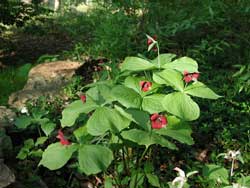Resource Library
Plant of the Week: Trillium, Red
The University of Arkansas System Division of Agriculture does not promote, support or recommend plants featured in "Plant of the Week." Please consult your local Extension office for plants suitable for your region.
Plant of the Week
Red Trillium
Latin: Trillium erectum

The eastern half of our country once consisted of a vast, mostly unbroken deciduous woodlands with a complex association of plants and animals that prospered in these shady places.
Trilliums - with their plant parts conveniently divided into units of three - made themselves at home and prospered. Though common in the woods, they’re less common in gardens because they’re slow to propagate and grow to flowering size.
Trillium was the genus name selected by Linnaeus because all parts of the plant - the leaves, the sepals, the flowers and the seed pod - are all divided into segments of three. Though primarily a New World species, four species are found in Asia. Traditionally, trilliums have been considered a part of the huge lily family, but modern taxonomic treatments now classify them in their own family.
A single unbranched stem arises from an underground rhizome in mid spring to produce a triplet of elliptical leaves. In some of the 40 or so species, the leaves are a respectable green but in others they are marked with a camouflaged blend of green, gray, purple and brown. Plant height varies from about 6 inches in some of the more diminutive species to about 18 inches in some larger kinds. Trilliums are considered spring ephemerals, but the foliage doesn’t die down until mid summer.
Though it’s always easy to identify these plants as trilliums, flowers vary considerably amongst the species. Some of the most common types such as T. recurvatum (purple trillium) or T. sessile (wake robin) have erect, three-parted purplish-brown petals that sit directly on the whorl of leaves and are best described as “interesting” instead of beautiful.
The more ornamental types grown for their showy flowers produce their single blossom at the end of a slender peduncle. The large white trillium (T. grandiflorum) is the most common in cultivation with white petals that merge into a funnel-shaped blossom, 2 inches across. T. erectum (red trillium or “Stinking Benjamin”) has a broad-spreading red flower atop an erect to nodding peduncle.
By many T. undulatum, the painted trillium, is considered the most beautiful of the group. It has white flowers marked with pink or red lines at the throat of the flower. This species is seldom seen today because its beauty and high demand led to over-collecting of wild populations in the middle of the last century.
As desirable as they are, trilliums aren’t commonly offered in the nursery trade. And when they’re offered, the conscientious gardener should make sure they’re nursery propagated plants, not wild-collected.
Even though slow, trilliums are remarkably easy to grow in a well-drained, humus-rich woodland soil. Newly planted trillium rhizomes usually will not flower for a year or two after being moved, but once they resume blooming will continue to do so for generations to come. The size of the colony will slowly increase from plantlets that arise from the original rhizome.
Trilliums produce fleshy seeds that are highly prized by ants that carry them off to eat the sweet aril attached to the seed coat. This ant dispersal mechanism is called myrmecochory - literally ant farming - and is an example of mutualism where both species benefit from the exchange. To ensure a compact colony of the species I grow, I simply remove the seeds from the capsule and plant them around the base of the original plant. First flowers usually occur on these seedlings in about 5 years.
By: Gerald Klingaman, retired
Extension Horticulturist - Ornamentals
Extension News - May 16, 2008
The University of Arkansas System Division of Agriculture does not maintain lists of retail outlets where these plants can be purchased. Please check your local nursery or other retail outlets to ask about the availability of these plants for your growing area.